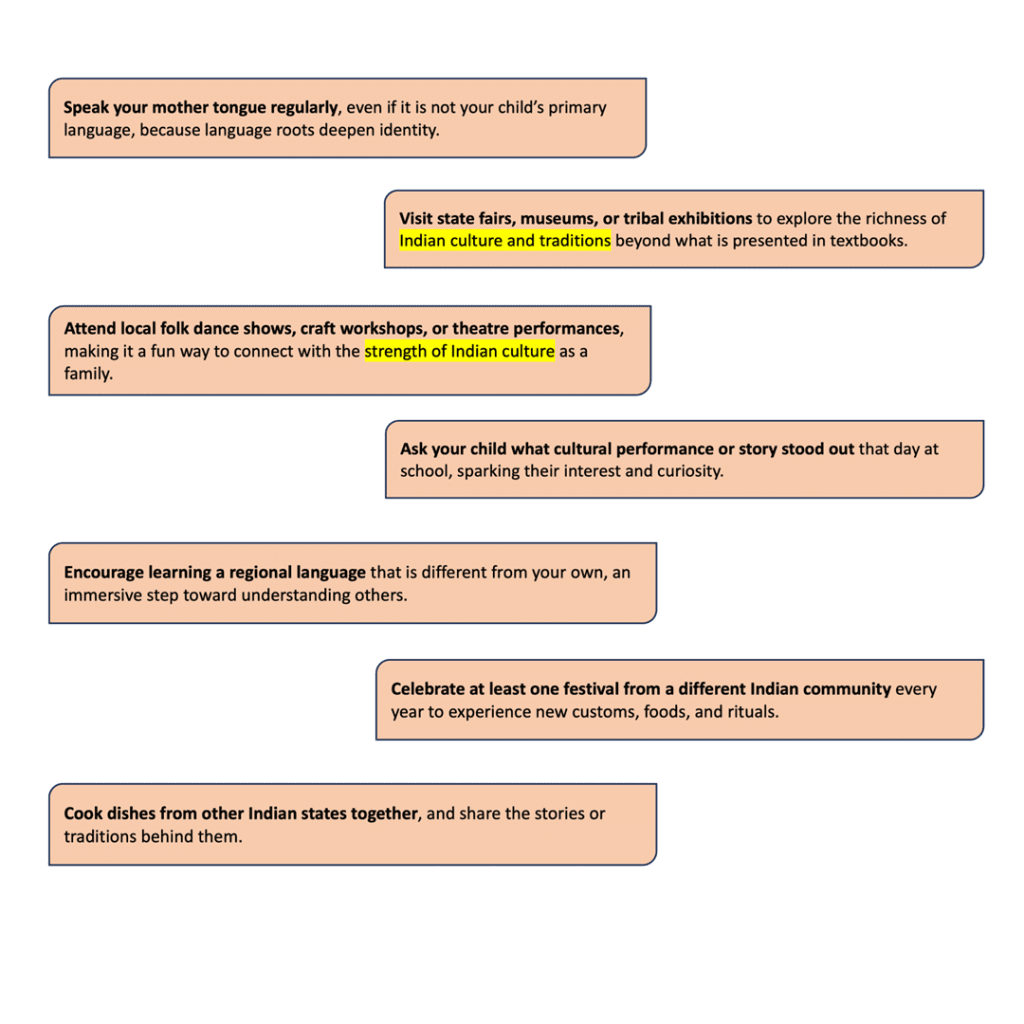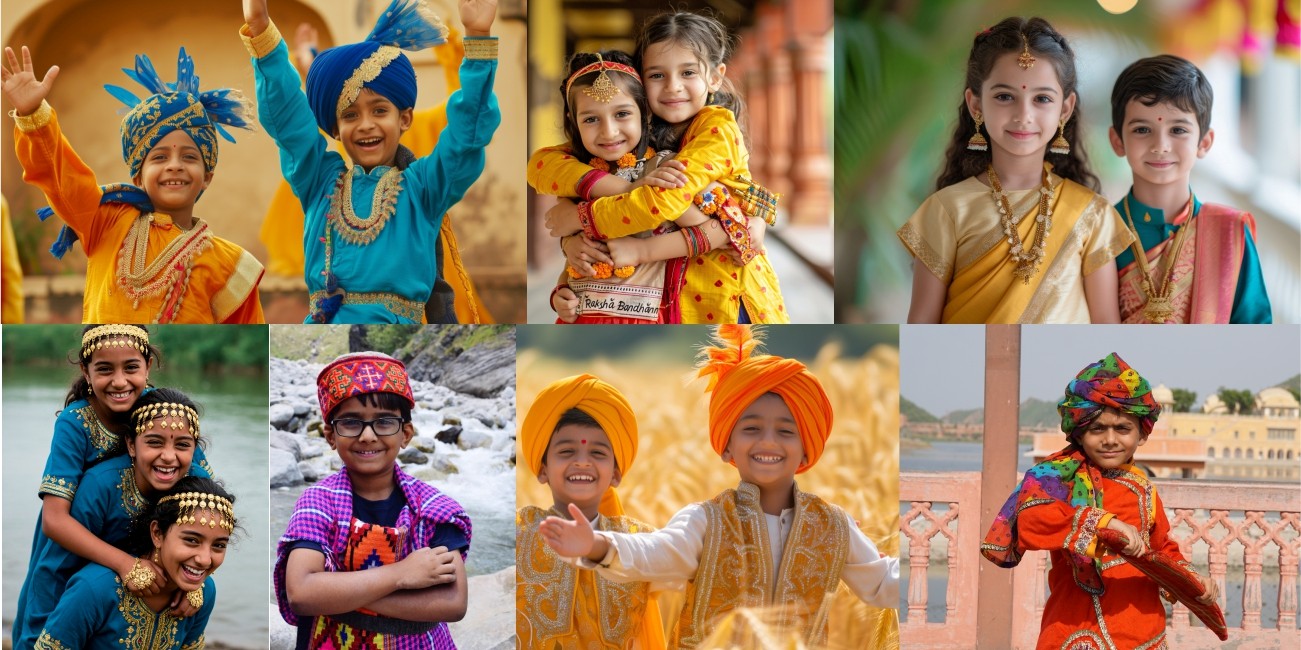![]()
From languages to landscapes, celebrating every difference brings us closer as a nation.
| In this article, you’ll find: •India, in numbers: A living mosaic •Freedom to be different, freedom in being recognised •From state to state, a shared story •India abroad: A display of heritage and unity •Classrooms that celebrate cultural diversity •Independence Day: Simple ideas with significant impact •For schools: What you can do •For parents: What you can do •Why do these initiatives matter? |

India speaks in many tongues, dresses in various styles, and prays in different ways – but it beats with one heart. From the snowy peaks of Kashmir to the southern shores of Kanyakumari, every festival and dialect reflects the cultural diversity of India. And as we prepare to celebrate Independence Day 2025, we honour the freedom of Indian culture and traditions, as well as the harmony we continue to build every single day.
India, in numbers: A living mosaic
India is one of the most culturally rich and diverse nations in the world. The strength of Indian culture lies in facts as much as in feelings:
| Over 2,000 ethnic groups, including 645 tribal communities |
| 123 major languages and 1,599 dialects |
| 300+ classical and folk dance forms, including Bharatnatyam, Bihu, Garba, Kalbelia, and more |
| 8 major religions, all practised freely |
| Thousands of festivals, each rooted in distinct regional beliefs |
These numbers are what make unity in diversity in India a lived reality.
Freedom to be different, freedom in being recognised
We often remember India’s independence as the fight against colonial rule. But real freedom is more about our right to express, be different, and feel accepted. Consider these inspiring stories:
- Ruma Devi: A self-taught artisan from Rajasthan, Ruma Devi has trained 22,000 artisans from 75 villages across the Thar region in Rajasthan through traditional embroidery, preserving heritage and generating income.
- T.M. Krishna: Carnatic vocalist T.M. Krishna brought Carnatic classical music to the Dalits and the slums. He challenges caste norms through music while protecting its soul.
- Siddalingaiah: Siddalingaiah, often hailed as the father of Kannada Dalit literature, co-founded the Dalit Sangharsha Samiti and was posthumously awarded the Padma Shri in 2021 for amplifying the voices of the marginalised community through poetry and activism.
These are some noteworthy stories that reflect the strength of Indian culture, where diversity is not only embraced but also celebrated and given a voice.
From state to state, a shared story
India’s diversity is vividly geographical; once you travel across the country, every state reveals a world of its own. In Nagaland, the Hornbill Festival brings together 17 major tribes to celebrate heritage through dances, games, and folklore. While Onam in Kerala is a grand homecoming, bringing Hindus, Christians, and Muslims together for feasts, boat races, and intricate floral rangoli, Lohri in Punjab warms winter nights with bonfires and folk songs. In Gujarat, Navratri brings vibrancy, as people from all backgrounds come together for garba, music, and festive celebrations.
All the moments showcase how India celebrates Independence Day with cultural diversity, making space for every voice and every tradition.
India abroad: A display of heritage and unity
Indian communities around the world carry their roots with pride. From national days to regional festivals, here are some ways that the diaspora continues to honour traditions that unite them across borders.
- New York City, USA: 78th Independence Day celebrations
Indians across NYC gathered at the Consulate, Times Square, and Lower Manhattan, celebrating with a flag hoisting ceremony, cultural performances, and participation by the diaspora.
- Dubai, UAE: Rath Yatra by Odisha Samaj
In a major diaspora gathering, around 500 Odias and other families participated in the 15th annual Rath Yatra, showcasing Odisha’s temple culture abroad.
- Sydney, Australia: Durga Puja at the Ponds Community Hub
The Bengali community in Sydney, Australia, organised traditional Durga Puja immersions, taking our rituals, music, and culture overseas. These global celebrations offer a cultural nostalgia and serve as reminders of Indian heritage and unity, echoing the spirit of unity in diversity across continents.
Classrooms that celebrate cultural diversity
In a country as diverse as India, classrooms are a rich mix of languages, traditions, and identities. Recognising this, educational policies are increasingly embracing cultural diversity as a strength.
| The 52nd report of the Commissioner for Linguistic Minorities highlights state efforts to encourage interaction among students from diverse linguistic communities, thereby further supporting the narrative of classroom diversity. |
| Even the 2023 Global Education Monitoring Report by UNESCO reinforces the value of inclusive, multilingual education. It also highlights India’s model as a promising, evidence-based approach to advancing SDG4 through cultural responsiveness and equity. |
Independence Day: Simple ideas with significant impact
For parents and educators, here are some meaningful Indian Independence Day celebration ideas that highlight the strength of Indian culture:
For schools: What you can do
- Flavours of India – A regional food flair: Turn the classroom into a mini food festival. Feature dishes such as Puran Poli, Makkai di Roti, and Sarson da Saag, each labelled with the state of origin. It is a delicious way to explore the diversity of Indian states.
- “My Language, My Pride” speech: Let each student greet the school with a “Happy Independence Day” in their mother tongue, followed by a short poem, rhyme, or greeting.
- Touch, see, learn – Cultural corners: Set up small learning stations for Rangoli, folk instruments, and other activities. Let students interact, learn, and appreciate the strength of Indian culture through hands-on experiences.
- Storytelling circles: Invite grandparents to share short folktales, rhymes, or personal stories in regional languages. It bridges generations and adds personal meaning to celebrating Independence Day in India.
- Performances that unite: Host an assembly featuring folk dances and music from across the country, such as Bihu, Bhangra, Lavani, or Manipuri dance, showcasing the artistic pulse of festivals of India and diversity.

Why do these initiatives matter?
These simple yet thoughtful efforts are far more than celebration ideas. They are acts of connection and preservation. This is why they count:
- Empathy grows through experience
When children learn a new language, perform a folk dance, or hear a story in another dialect, they begin to see the world through someone else’s eyes.
- Inclusion begins with visibility
Cultural diversity activities ensure that students from smaller or lesser-known communities feel seen, valued, and proud of their identity.
- Protecting heritage starts early
India is losing hundreds of its languages. Of the 780 living languages, many are at risk of vanishing. Supporting multilingual learning helps protect this living heritage.
- Fostering respect, not stereotypes
Hands-on exposure to diverse cultures reduces prejudice, encourages open dialogue, and fosters a sense of familiarity, replacing fear with understanding.
- Unity strengthens resilience
During Cyclone Fani, multilingual communication played a crucial role in evacuating over a million people safely in Odisha, demonstrating that inclusive messaging can save lives.
Independence is meaningful when it includes every voice, honours every identity, and protects every tradition. As we mark Independence Day 2025, India, the true celebration lies in how we recognise and respect the differences that define us. Across homes, schools, and communities, embracing the cultural diversity in India isn’t a gesture – it is a responsibility. When we speak in many languages yet act with shared purpose, we strengthen the soul of this nation. So, this Independence Day, let’s carry that force into the future – through the way we live, the way we listen, and the way we stand beside one another.
